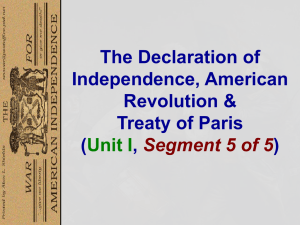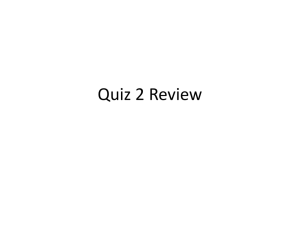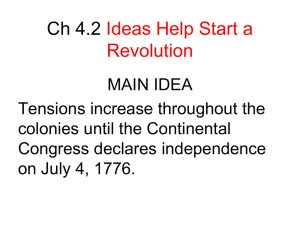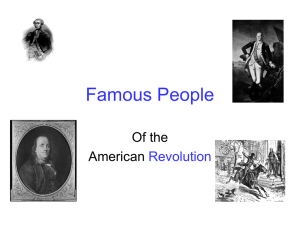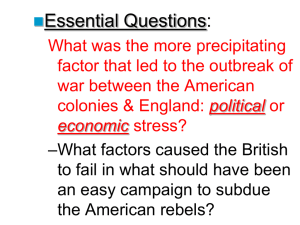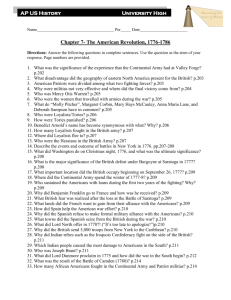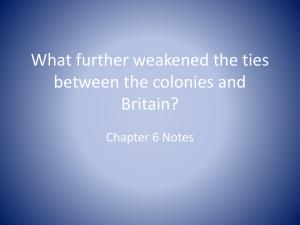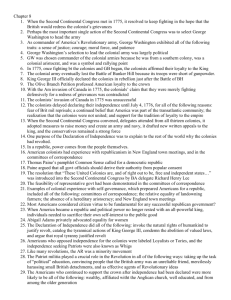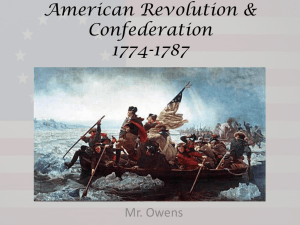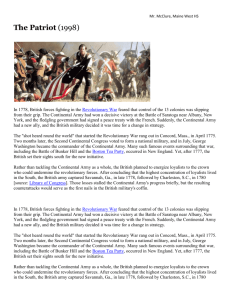THE AMERICAN REVOLUTION
advertisement
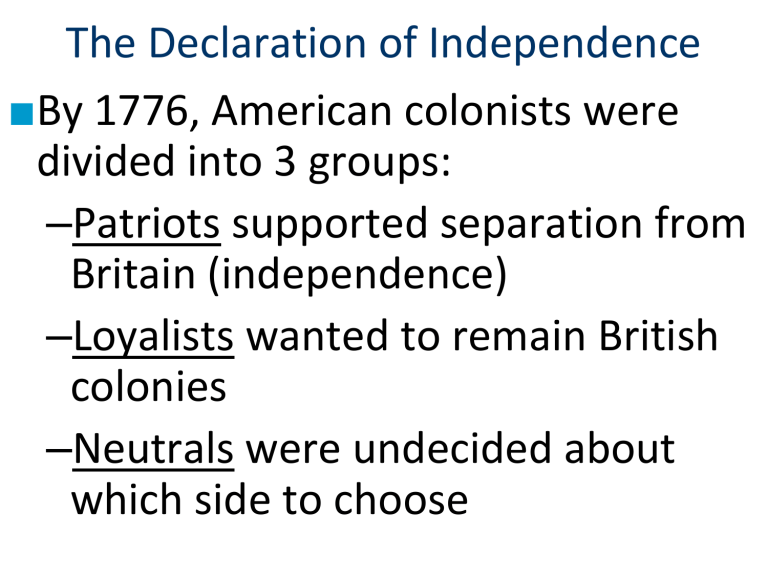
The Declaration of Independence ■By 1776, American colonists were divided into 3 groups: –Patriots supported separation from Britain (independence) –Loyalists wanted to remain British colonies –Neutrals were undecided about which side to choose The “Sons of Colonists formed the FirstLiberty” Continental urged Congress to help Americans in Boston; colonial resistance Formed Committees of Correspondence to to the Stamp Act increase communication among Americans using violence, if necessary Britain passed the Coercive Acts (Intolerable Acts) to punish colonists The Enlightenment ■The American Revolution was inspired by the Enlightenment: –John Locke—all men are born with natural rights & citizens can revolt from tyrannical gov’ts –Montesquieu—separation of powers; checks & balances –Thomas Paine’s Common Sense urged colonial independence By July 1776, how had colonial attitudes towards Great Britain changed? The Declaration of Independence All 1776, men are born with “naturalwere rights” ■By July enough Americans of life, liberty, & property “patriots” that members of the Second Continental Congress formed 5-man Citizens can break theirasocial contract witha their gov’t when committee to draft Declaration of their gov’t becomes tyrannical Independence: –Thomas Jefferson of Virginia was the principal author –It was based on the “enlightened” ideas of John Locke & explained why the colonists were rebelling Quick Class Discussion: Based on this word cloud, hypothesize THREE major themes present in the Declaration of Independence? Declaration of Independence (July 4, 1776) Committee to draft the Declaration: Thomas Jefferson, Ben Franklin, John Adams, Robert Livingston, & Roger Sherman The Declaration of Independence & Influences from the Enlightenment Independence Hall at the Second Continental Congress The American Revolution ■The Dec of Independence was a formal demand for separation, but the Revolutionary War had already begun in 1775: –Lexington & Concord –Formation of a Continental Army under George Washington –Americans were divided among Patriots, Loyalists, & Neutrals Patriots vs. Loyalists ■ Where were the Loyalists? ■ Why were Loyalists near cities? ■ Why are Indians loyalists? Fighting the Revolutionary War Quick Class Discussion ■ What was the biggest advantage the American colonists had during the Revolutionary War? ■ What was the biggest advantage that Great Britain had during the Revolutionary War? ■ Based on this chart, who should win the war? Revolutionary War ■ When the war began, the British had a clear military advantage: –400% larger & more experienced army –More money –The world’s most dominant navy –Manufacturing to make war supplies Revolutionary War To the win,American the English had to find & ■ But, defeathad: the Continental Army colonists –Familiarity with the environment –A commitment to win Britain under-estimated the colonial the war commitment to independence –Short supply lines to their soldiers –A defensive strategy to outlast the British The Role of George Washington ■As leader of the Continental Army, George Washington was the symbol of the American cause: –He had to build a professional army & coordinate the militias –Encouraged common citizens & volunteer soldiers to support the war even when the British seemed destined to win during the early years of the revolution American Military: Continental Army, Colonial Militias, & Civilians General Differing Washington Military The Americans General StrategiesGage The British ■ Outlast the British ■ Divide & Conquer –Use Loyalists, seize –Defend colonial property, lands & drag out encourage slave the war revolts –Guerilla tactics –Split the Northern –Make an alliance & Southern with France colonies As long as Britain did not defeat the –Blockade ports Continental Army, England could not winto prevent trade The American Revolution began at Lexington & Concord British victories from 1776-1777 made an American victory look impossible British Seizure & Burning of New York, 1776 On Christmas Eve 1776, Washington gave Americans hope by crossing the Delaware River & surprising British troops in Trenton, NJ Crossing the Delaware in route to a surprise attack at Trenton & Princeton, 1776 The French Alliance ■From the beginning of the war, American diplomats, led by Benjamin Franklin, tried to form an alliance with the French: –The French gov’t was willing, but needed to see that the Americans had a chance to win –The French agreed to join the American cause after the battle of Saratoga in 1777 The Battle of Saratoga was a turning point because France joined the Americans as an ally The “turning point” of the Revolution: Marquis de The Battle of Saratoga, 1777 Lafayette After Saratoga, French general Lafayette helped train American troops while the French navy helped neutralize the British advantage on the high seas When French troops arrived in the spring 1778, the tide of the war shifted in favor of the Americans During the winter of 1777-78, Continental Army troops nearly starved at Valley Forge, PA but Washington & Lafayette inspired & trained the troops to continue the fight Near Starvation at Valley Forge, PA in 1778 From 1778-1781, both sides traded victories, but the war finally came to a conclusion at the Battle of Yorktown The Battle of Yorktown Video By 1781, Washington trapped the army of British General Cornwallis between the Continental Army & the French navy General Cornwallis surrendered to Washington The Battle of Yorktown in 1781, ending the American Revolution Cornwallis’ surrender was the “day the world turned upside down” The Treaty of Paris (1783) ■The Treaty of Paris in 1783 ended the American Revolution ■The treaty gave America: – Full independence – All territory east of Mississippi River, between Canada & FL – The removal of the British army from U.S. claims in America North America after the Treaty of Paris, 1783 How did America change from 1763 to 1783? In your answer consider government authority, territorial expansion, & American identity
